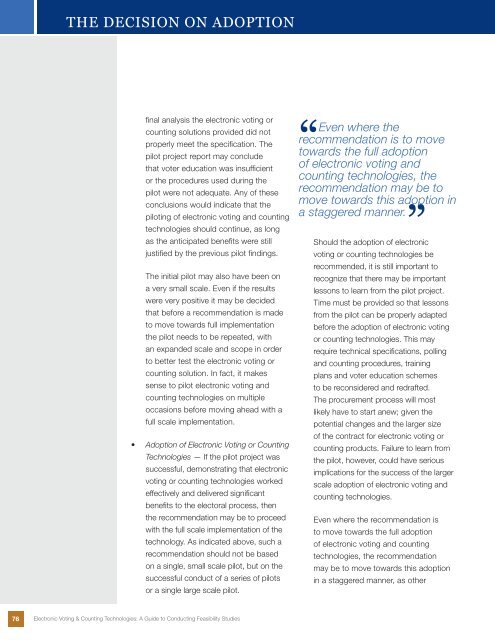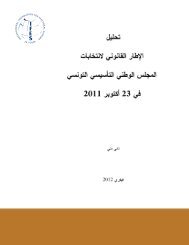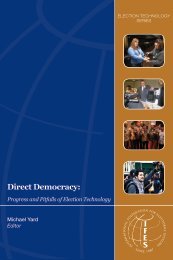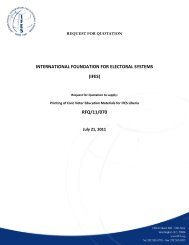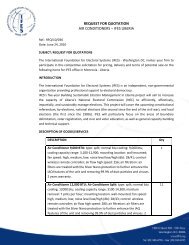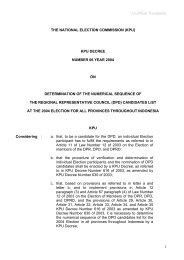Electronic Voting & Counting Technologies - IFES
Electronic Voting & Counting Technologies - IFES
Electronic Voting & Counting Technologies - IFES
- No tags were found...
You also want an ePaper? Increase the reach of your titles
YUMPU automatically turns print PDFs into web optimized ePapers that Google loves.
INTERNATIONAL THE DECISION ON ELECTORAL ADOPTIONSTANDARDSfinal analysis the electronic voting orcounting solutions provided did notproperly meet the specification. Thepilot project report may concludethat voter education was insufficientor the procedures used during thepilot were not adequate. Any of theseconclusions would indicate that thepiloting of electronic voting and countingtechnologies should continue, as longas the anticipated benefits were stilljustified by the previous pilot findings.The initial pilot may also have been ona very small scale. Even if the resultswere very positive it may be decidedthat before a recommendation is madeto move towards full implementationthe pilot needs to be repeated, withan expanded scale and scope in orderto better test the electronic voting orcounting solution. In fact, it makessense to pilot electronic voting andcounting technologies on multipleoccasions before moving ahead with afull scale implementation.• Adoption of <strong>Electronic</strong> <strong>Voting</strong> or <strong>Counting</strong><strong>Technologies</strong> — If the pilot project wassuccessful, demonstrating that electronicvoting or counting technologies workedeffectively and delivered significantbenefits to the electoral process, thenthe recommendation may be to proceedwith the full scale implementation of thetechnology. As indicated above, such arecommendation should not be basedon a single, small scale pilot, but on thesuccessful conduct of a series of pilotsor a single large scale pilot.“Even where therecommendation is to movetowards the full adoptionof electronic voting andcounting technologies, therecommendation may be tomove towards this adoption ina staggered manner.”Should the adoption of electronicvoting or counting technologies berecommended, it is still important torecognize that there may be importantlessons to learn from the pilot project.Time must be provided so that lessonsfrom the pilot can be properly adaptedbefore the adoption of electronic votingor counting technologies. This mayrequire technical specifications, pollingand counting procedures, trainingplans and voter education schemesto be reconsidered and redrafted.The procurement process will mostlikely have to start anew; given thepotential changes and the larger sizeof the contract for electronic voting orcounting products. Failure to learn fromthe pilot, however, could have seriousimplications for the success of the largerscale adoption of electronic voting andcounting technologies.Even where the recommendation isto move towards the full adoptionof electronic voting and countingtechnologies, the recommendationmay be to move towards this adoptionin a staggered manner, as other76<strong>Electronic</strong> <strong>Voting</strong> & <strong>Counting</strong> <strong>Technologies</strong>: A Guide to Conducting Feasibility Studies


